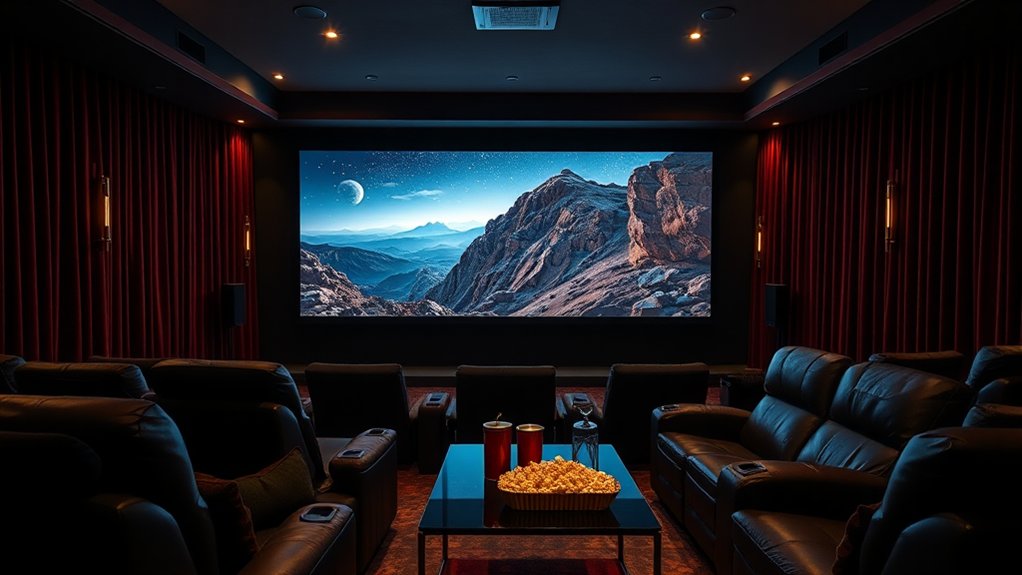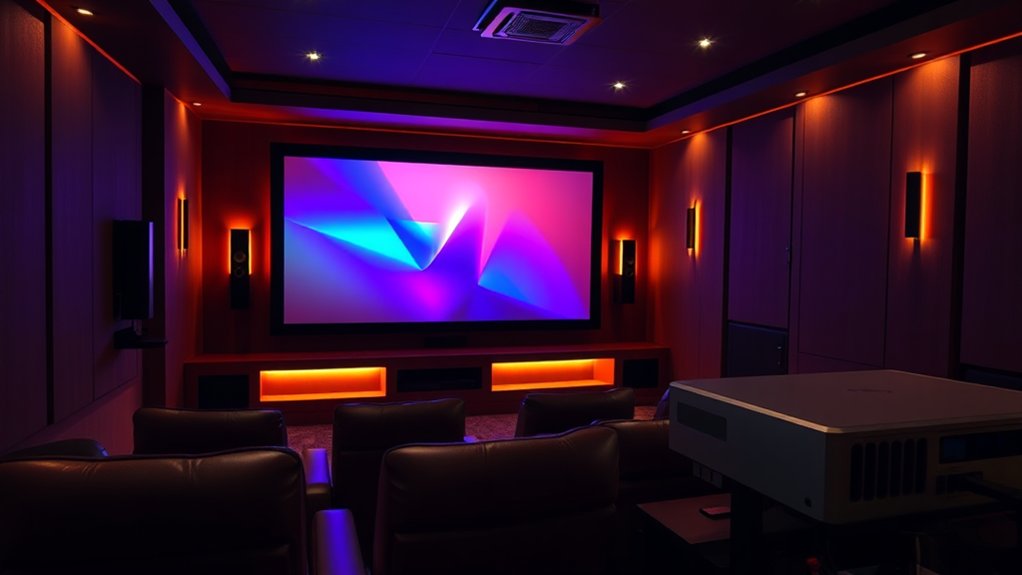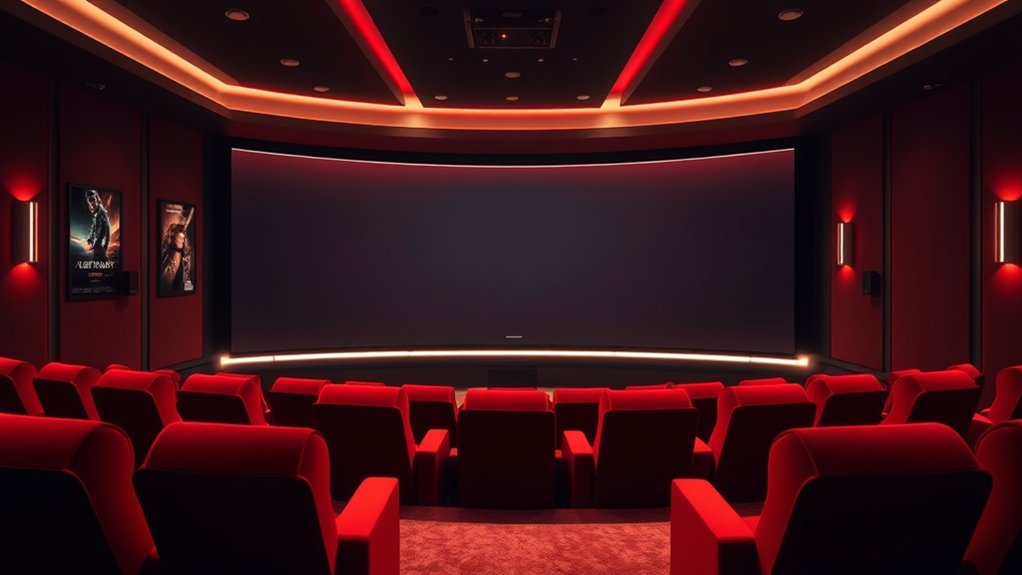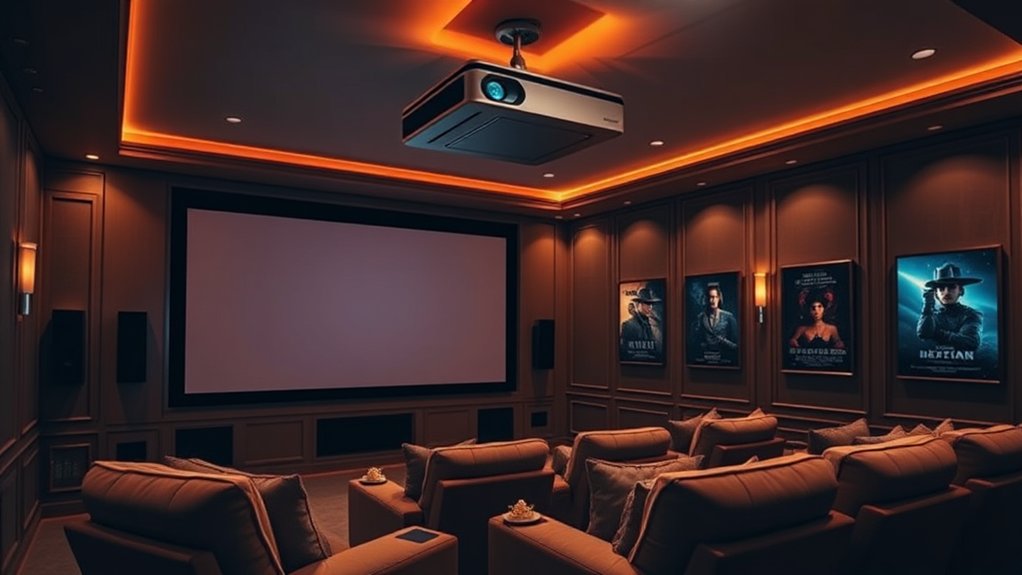When regarding watching movies, the best screen aspect ratio is usually 16:9. This ratio fits modern HDTVs perfectly, enhancing your viewing experience by minimizing black bars during films and sports. It balances cinematic visuals with the intimacy of storytelling, making you feel like you’re part of the action. Of course, there are other ratios like 1.85:1 and 2.4:1 that offer different experiences. Curious about how these ratios can impact your home theater setup?
Key Highlights
- The 16:9 aspect ratio is ideal for most movies and aligns perfectly with modern HDTVs and streaming services.
- The 1.85:1 aspect ratio provides a balance of spaciousness and intimacy, focusing on character-driven storytelling.
- The 2.4:1 Cinemascope ratio is favored for epic visuals, enhancing immersive experiences in dedicated home theaters.
- Choosing the right aspect ratio reduces black bars and enhances viewing comfort during various movie genres.
- Future trends suggest a rise in 21:9 projectors, offering an ultrawide experience that elevates home movie viewing.
Understanding Aspect Ratios
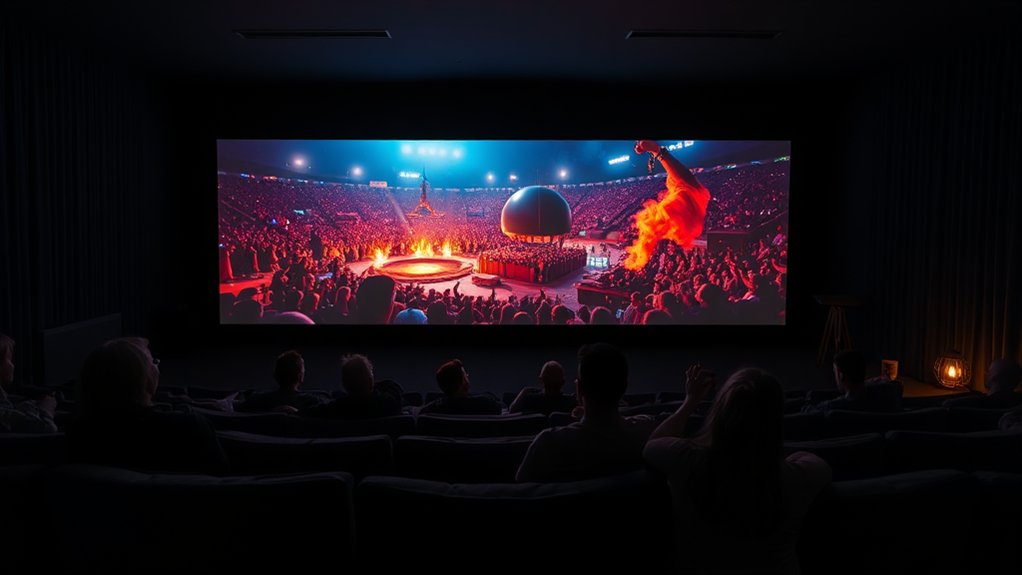
In relation to movies, the term “aspect ratio” might sound a bit technical, but at its core, it simply refers to the width and height of the screen image you’re watching.
Think of it as the shape of the picture—like choosing between a rectangular photo or a square one.
Commonly, you’ll encounter a variety of ratios, such as 16:9, which is standard for HDTVs, but others, like 21:9 for ultrawide screens, can provide a more immersive experience, especially with epic scenery. Specific aspect ratios can enhance visual storytelling and audience perception of the film. Additionally, the aspect ratio plays a significant role in defining the visual aesthetics of a film.
Explore the world of aspect ratios, from standard 16:9 to immersive 21:9, enhancing your cinematic experience!
Here’s a fun fact: when a 21:9 movie is shown on a 16:9 screen, you get those black bars at the top and bottom—why not bring the cinematic experience home in style?
Understanding these dimensions helps you appreciate visual storytelling.
Importance of 16:9 for Home Viewing
Selecting the right aspect ratio can greatly boost your home viewing experience, especially regarding the widely accepted 16:9 format. This ratio is virtually a universal choice, perfectly aligning with modern HDTVs and streaming services. Imagine watching your favorite sports or the latest series without those annoying black bars ruining the action—it’s bliss! With a 16:9 screen, you’ll enjoy a cinematic feel that doesn’t compromise when shifting from movies to shows and vice versa. Furthermore, it fits well in most living rooms without dominating the space, providing a balanced look. Adhering to SMPTE guidelines enhances your viewing comfort by ensuring clarity and optimal viewing angles. 16:9 is popular for high-definition broadcasts isn’t it great when technology makes things simpler? Investing in a 16:9 setup not only raises your viewing comfort, it also improves your overall entertainment experience.
Exploring the 1.85:1 Cinema Ratio
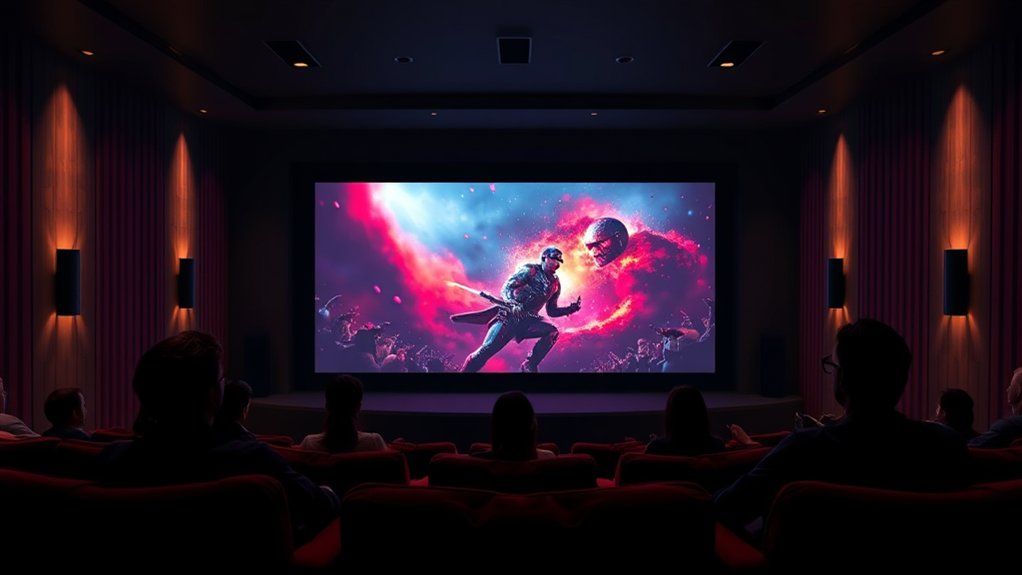
Even though you mightn’t think much about aspect ratios when diving into a movie, the 1.85:1 cinema ratio plays a significant role in shaping your viewing experience. Emerging in the 1950s, this ratio offers a comfortable balance, aligning closely with how we naturally view scenes. Unlike the square-ish 1.33:1 or the ultra-wide 2.39:1, 1.85:1 provides a spacious yet intimate framing, letting you focus on characters and story without distractions. Early cinema’s composition styles have influenced how filmmakers utilize this aspect ratio to enhance storytelling. You may have seen it in classics like *Schindler’s List* and modern hits like *Joker*. This aspect ratio fits perfectly on most theater screens, enhancing immersion without making you feel like you’re watching from halfway across the universe—talk about a cinematic win!
The Spectacle of 2.4:1 Cinemascope
The breathtaking sweep of the 2.4:1 Cinemascope aspect ratio transports viewers into a world where visuals reign supreme, enhancing every larger-than-life production.
This ratio stretches the cinematic experience, allowing filmmakers to showcase epic vistas and intricate scenes with stunning clarity. By using anamorphic lenses that squeeze images, they manage to capture more without needing larger film formats. How cool is that?
The 2.4:1 format perfectly matches your horizontal vision, immersing you in vast narratives as you gaze at the expansive visuals on screen.
Even though this wider frame leads to letterboxing on standard TVs, cinephiles prefer it in dedicated spaces, savoring the authenticity and scale it delivers. After all, who wouldn’t want to feel like they’re part of the action?
Historical Context of 4:3 Aspect Ratio
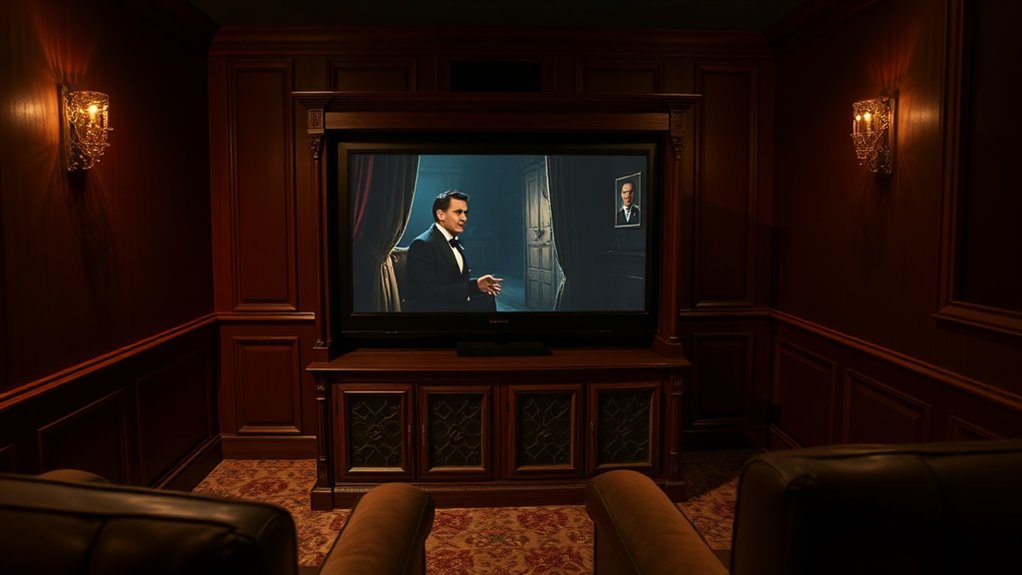
Once a reigning champion in the domain of visual storytelling, the 4:3 aspect ratio boasts a rich history that reflects the evolution of both television and cinema.
Originally standardized from the 1.33:1 ratio, it became the go-to format for early cinema before television took off in the 1940s and 1950s. As box-style CRT TVs emerged, manufacturers adopted 4:3 to guarantee a seamless watching experience—the standardization made it easy to showcase films at home.
Standardized from 1.33:1, the 4:3 ratio became synonymous with the golden age of cinema and early television.
TV shows welcomed this format, shaping how you perceived stories. During the widescreen transformation in cinema, with formats like CinemaScope, changed the game, the 4:3 ratio stubbornly lingered in living rooms, forever defining an era of “classic” TV.
Who doesn’t recall that boxy nostalgia?
Choosing the Right Ratio for Your Screen
In the world of visual storytelling, the choice of screen aspect ratio can feel as challenging as choosing a favorite movie genre; it all depends on what you want to experience.
If you’re streaming your favorite shows, a 16:9 ratio works best since it’s the standard for most TVs and platforms, offering versatility and comfort.
Conversely, if you’re gearing up for an epic film night, consider embracing the 2.39:1 ratio—it fills your screen with breathtaking vistas and action, making you feel part of the story.
Just remember, although cropping can adapt formats, you may lose some key visuals.
Enhancing the Movie Experience With Widescreen
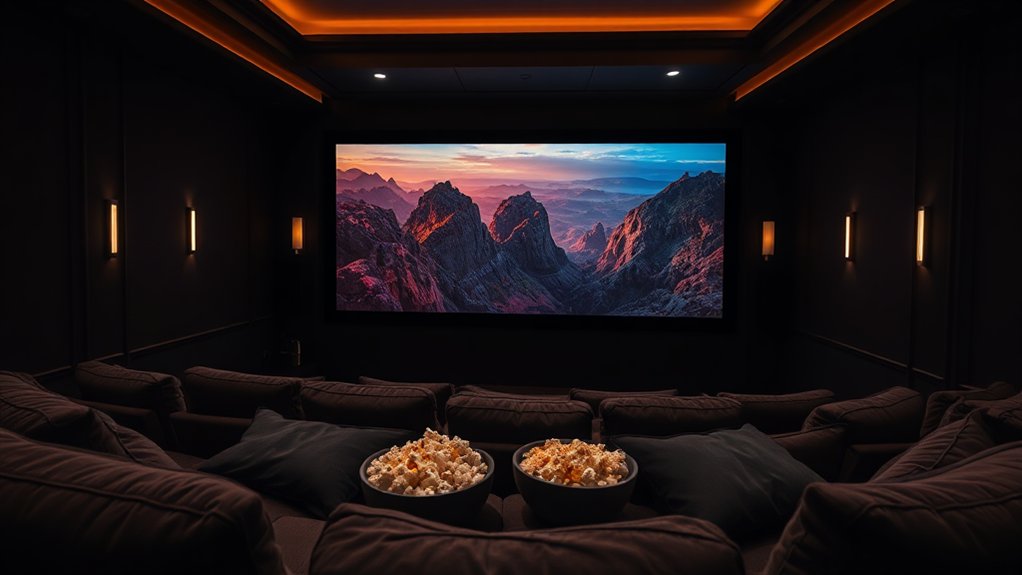
Though you might think the experience of watching a movie is all about the plot and performances, the aspect ratio plays a crucial role in how the story unfolds before your eyes.
Widescreen formats, like 2.35:1 or 2.39:1, expand your viewing field, immersing you deeper in the narrative, as if you’re living the adventure rather than just watching it. Picture epic vistas or intimate character moments beautifully showcased, drawing you into the emotions on screen.
Most blockbuster movies today adopt these formats, maximizing your visual engagement. By filling your peripheral vision, widescreen mitigates distractions, anchoring your focus where it belongs—on the story.
Who wouldn’t want to feel the grand scale of a stunning sci-fi universe or the tension of a suspenseful drama?
Future Trends in Aspect Ratios for Projectors
As technology evolves, so does the way you experience movies, especially regarding projectors and aspect ratios. By 2025, the 21:9 aspect ratio is expected to dominate, providing a near-panoramic view that immerses you deeper into the story.
Envision this: ultrawide projectors not only improve your home theater but also reduce those annoying black bars you hate. Plus, content creators are jumping on board, offering videos in wider formats to save you from letterboxing.
With smart projectors, including AI-driven features, switching between aspect ratios without lifting a finger will soon be the norm. Consider it—no more fussing with settings during movie night! This seamless integration will boost your viewing experience and keep things convenient, don’t you think?
Frequently Asked Questions
How Does Aspect Ratio Affect Audio Quality During Playback?
Aspect ratio doesn’t directly affect audio quality during playback. Whereas visual framing may influence your perception of sound, the audio remains consistent regardless of the screen’s dimensions or ratios used in playback.
Can Aspect Ratios Influence Viewer Emotions or Perceptions?
Yes, aspect ratios can influence your emotions and perceptions. Wider ratios create grandeur, whereas narrower ones evoke intimacy. Filmmakers use these formats purposefully, shaping moods and directing your attention throughout their narratives.
Are There Any Health Implications of Viewing at Certain Aspect Ratios?
Certain aspect ratios can indirectly impact your health by influencing viewing distance and posture, causing eye strain or discomfort. Maintaining proper screen size and resolution is crucial for minimizing visual fatigue and ensuring comfort during prolonged use.
What Aspect Ratio Is Best for Gaming Compared to Movies?
When gaming, a 21:9 aspect ratio improves immersion, giving you a broader view. Nonetheless, for movies, 16:9 fits standard content better, whereas 21:9 offers a cinematic experience. Choose based on what you play or watch more.
How Do Different Aspect Ratios Impact Subtitles Visibility?
Different aspect ratios impact subtitle visibility greatly. When you watch wider films, subtitles can get cut off or hard to read. Narrower ratios help guarantee subtitles fit within the screen, enhancing your viewing experience.

